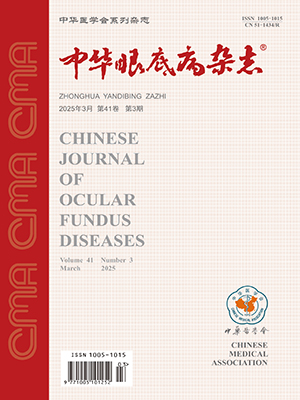| 1. |
Dupas B, Tadayoni R, Gaudric A. Epiretinal membranes[J]. J Fr Ophtalmol, 2015, 38(9): 861-875. DOI: 10.1016/j.jfo.2015.08.004.
|
| 2. |
Matoba R, Morizane Y. Surgical treatment of epiretinal membrane[J]. Acta Med Okayama, 2021, 75(4):403-413. DOI: 10.18926/AMO/62378.
|
| 3. |
Almony A, Holekamp NM, Bai F, et al. Small-gauge vitrectomy does not protect against nuclear sclerotic cataract[J]. Retina, 2012, 32(3): 499-505. DOI: 10.1097/IAE.0b013e31822529cf.
|
| 4. |
Saito Y, Lewis JM, Park I, et al. Nonvitrectomizing vitreous surgery: a strategy to prevent postoperative nuclear sclerosis[J]. Ophthalmology, 1999, 106(8): 1541-1545. DOI: 10.1016/S0161-6420(99)90451-7.
|
| 5. |
Sawa M, Ohji M, Kusaka S, et al. Nonvitrectomizing vitreous surgery for epiretinal membrane[J]. Ophthalmology, 2005, 112(8): 1402-1408. DOI: 10.1016/j.ophtha.2005.02.014.
|
| 6. |
Reibaldi M, Longo A, Avitabile T. Transconjunctival nonvitrectomizing vitreous surgery versus 25-gauge vitrectomy in patients with epiretinal membrane: a prospective randomized study[J]. Retina, 2015, 35(5): 873-879. DOI: 10.1097/IAE.0000000000000459.
|
| 7. |
Bu SC, Kuijer R, Li XR, et al. Idiopathic epiretinal membrane[J]. Retina, 2014, 34(12): 2317-2335. DOI: 10.1097/IAE.0000000000000349.
|
| 8. |
Holekamp NM, Shui YB, Beebe DC. Vitrectomy surgery increases oxygen exposure to the lens: a possible mechanism for nuclear cataract formation[J]. Am J Ophthalmol, 2005, 139(2): 302-310. DOI: 10.1016/j.ajo.2004.09.046.
|
| 9. |
Charles S. Vitreous microsurgery[M]. 2nd ed. Baltimore: Williams & Wilkins, 1987: 153-157.
|
| 10. |
Kim JS, Chung SH, Joo CK. Clinical application of a Scheimpflug system for lens density measurements in phacoemulsification[J]. Cataract Refract Surg, 2009, 35(7): 1204-1209. DOI: 10.1016/j.jcrs.2009.02.032.
|
| 11. |
Zhang Y, Dong J, Zhang S, et al. Corneal astigmatism measurements comparison among ray-tracing aberrometry, partial coherenceinterferometry, and Scheimpflug imaging system[J/OL]. J Ophthalmol, 2020, 2020: 3012748[2020-04-01]. https://doi.org/10.1155/2020/3012748. DOI: 10.1155/2020/3012748.
|
| 12. |
Faria-Correia F, Ramos I, Lopes B, et al. Correlations of objective metrics for quantifying dysfunctional lens syndrome with visual acuity and phacodynamics[J]. J Refract Surg, 2017, 33(2): 79-83. DOI: 10.3928/1081597X-20161206-05.
|
| 13. |
Chen Y, Xia X. Comparison of the Orbscan Ⅱ topographer and the iTrace aberrometer for the measurements of keratometry and corneal diameter in myopic patients[J]. BMC Ophthalmol, 2016, 31: 33. DOI: 10.1186/s12886-016-0210-8.
|
| 14. |
万修华, 熊瑛, 余翔, 等. 瞳孔直径对波前像差的影响[J]. 眼科, 2011, 20(3): 181-185.Wu XH, Xiong Y, Yu X, et al. The analysis of the impact of pupil diameter on wavefront aberration[J]. Ophthalmol CHN, 2011, 20(3): 181-185.
|
| 15. |
Chen H, Chi W, Cai X, et al. Macular microvasculature features before and after vitrectomy in idiopathic macular epiretinal membrane: an OCT angiography analysis[J]. Eye, 2019, 33(4): 619-628. DOI: 10.1038/s41433-018-0272-3.
|
| 16. |
Kitagawa Y, Shimada H, Shinojima A, et al. Foveal avascular zone area analysis using optical coherence tomography angiography before and after idiopathic epiretinal membrane surgery[J]. Retina, 2019, 39(2): 339-346. DOI: 10.1097/IAE.0000000000001972.
|
| 17. |
杨天静, 蒋沁, 沈轶. 玻璃体切割联合黄斑前膜及内界膜剥除术后患者黄斑中心凹视网膜厚度、无血管区面积及微血管密度的变化[J]. 眼科新进展, 2021, 41(4): 350-353. DOI: 10.13389/j.cnki.rao.2021.0073.Yang TJ, Jiang Q, Shen Y. Changes in macular thickness, foveal avascular zone area, arid vessel density after vitrectomy with epiretinal membrane and internal limiting membrane[J]. Rec Adv Ophthalmol, 2021, 41(4): 350-353. DOI: 10.13389/j.cnki.rao.2021.0073.
|
| 18. |
张锐, 高自清, 王爱芹. 光学相干断层扫描血管成像在特发性黄斑前膜玻璃体切除术后疗效观察中的应用[J]. 中华解剖与临床杂志, 2021, 26(1): 78-82. DOI: 10.3760/cma.j.cn101202-20200728-00240.Zhang R, Gao ZQ, Wang AQ. Application of the optical coherence tomography angiography in the observation of the curative effect after the idiopathic macular vitrectomy[J]. Chin J Anat Clin, 2021, 26(1): 78-82. DOI: 10.3760/cma.j.cn101202-20200728-00240.
|
| 19. |
Sandali O, El Sanharawi M, Basli E, et al. Epiretinal membrane recurrence: incidence, characteristics, evolution, and preventive and risk factors[J]. Retina, 2013, 33(10): 2032-2038. DOI: 10.1097/IAE.0b013e31828d2fd6.
|
| 20. |
刘建东, 高荣玉, 徐鑫彦, 等. 非玻璃体切割手术治疗特发性黄斑前膜的疗效观察[J]. 中华眼底病杂志, 2020, 36(5): 379-383. DOI: 10.3760/cma.j.cn511434-20191011-00322.Liu JD, Gao YR, Xu XY, et al. Clinical effect of non-vitrectomy in the treatment of idiopathic macular epiretinal membranes[J]. Chin J Ocul Fudnus Dis, 2020, 36(5): 379-383. DOI: 10.3760/cma.j.cn511434-20191011-00322.
|




